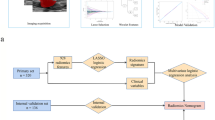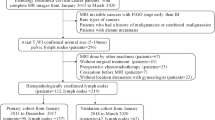Abstract
Purpose
To develop and identify a MRI-based radiomics nomogram for the preoperative prediction of parametrial invasion (PMI) in patients with early-stage cervical cancer (ECC).
Materials and methods
All 137 patients with ECC (FIGO stages IB–IIA) underwent T2WI and DWI scans before radical hysterectomy surgery. The radiomics signatures were calculated with the radiomics features which were extracted from T2WI and DWI and selected by the least absolute shrinkage and selection operation regression. The support vector machine (SVM) models were built using radiomics signatures derived from T2WI and joint T2WI and DWI respectively to evaluate the performance of radiomics signatures for distinguishing patients with PMI. A radiomics nomogram was drawn based on the radiomics signatures with a better performance, patient’s age, and pathological grade; its discrimination and calibration performances were estimated.
Results
For T2WI and joint T2WI and DWI, the radiomics signatures yielded an AUC of 0.797 (95% CI, 0.682–0.911) vs 0.946 (95% CI, 0.899–0.994), and 0.780 (95% CI, 0.641–0.920) vs 0.921 (95% CI, 0.832–1) respectively in the primary and validation cohorts. The radiomics nomogram, integrating the radiomics signatures from joint T2WI and DWI, patient’s age, and pathological grade, showed excellent discrimination, with C-index values of 0.969 (95% CI, 0.933–1) and 0.941 (95% CI, 0.868–1) in the primary and validation cohorts, respectively. The calibration curve showed a good agreement.
Conclusions
The radiomics nomogram performed well for the preoperative prediction of PMI in patients with ECC and may be used as a supplementary tool to provide individualized treatment plans for patients with ECC.
Key Points
• No previously reported study that has utilized radiomics nomogram to preoperatively predict PMI for patients with ECC.
• Radiomics model involves radiomics features extracted from joint T2WI and DWI which characterize the heterogeneity between tumors in patients with ECC.
• Radiomics nomogram can assist clinicians with individualized treatment decision-making for patients with ECC.





Similar content being viewed by others
Abbreviations
- CI:
-
Confidence interval
- ECC:
-
Early-stage cervical cancer
- FIGO:
-
International Federation of Gynecology and Obstetrics
- H–L:
-
Hosmer-Lemeshow test
- LASSO:
-
Least absolute shrinkage and selection operator
- PMI:
-
Parametrial invasion
- ROC:
-
Receiver operating curve
- SCC:
-
Ag squamous cell carcinoma antigen level
- SVM:
-
Support vector machine
- T2WI:
-
T2-weighted imaging
References
Cohen PA, Jhingran A, Oaknin A, Denny L (2019) Cervical cancer. Lancet 393:169–182
Vanichtantikul A, Tantbirojn P, Manchana T (2017) Parametrial involvement in women with low-risk, early-stage cervical cancer. Eur J Cancer Care (Engl) 26:1–5
Woo S, Kim SY, Cho JY, Kim SH (2018) Apparent diffusion coefficient for prediction of parametrial invasion in cervical cancer: a critical evaluation based on stratification to a Likert scale using T2-weighted imaging. Radiol Med 123:209–216
Ma C, Zhang Y, Li R, Mao HL, Liu PS (2018) Risk of parametrial invasion in women with early stage cervical cancer: a meta-analysis. Arch Gynecol Obstet 297:573–580
Baiocchi G, de Brot L, Faloppa CC et al (2017) Is parametrectomy always necessary in early-stage cervical cancer? Gynecol Oncol 146:16–19
Dabi Y, Willecocq C, Ballester M et al (2018) Identification of a low risk population for parametrial invasion in patients with early-stage cervical cancer. J Transl Med 16:1–9
Qu JR, Qin L, Li X et al (2018) Predicting parametrial invasion in cervical carcinoma (stages IB1, IB2, and IIA): diagnostic accuracy of T2-weighted imaging combined with DWI at 3 T. AJR Am J Roentgenol 210(3):677–684
Woo S, Suh CH, Kim SY, Cho JY, Kim SH (2018) Magnetic resonance imaging for detection of parametrial invasion in cervical cancer: an updated systematic review and meta-analysis of the literature between 2012 and 2016. Eur Radiol 28:530–541
Liu Z, Wang S, Dong D et al (2019) The applications of radiomics in precision diagnosis and treatment of oncology: opportunities and challenges. Theranostics 9:1303–1322
Lambin P, Rios-Velazquez E, Leijenaar R et al (2012) Radiomics: extracting more information from medical images using advanced feature analysis. Eur J Cancer 48:441–446
Gillies RJ, Kinahan PE, Hricak H (2016) Radiomics: images are more than pictures, they are data. Radiology 278:563–577
Becker AS, Ghafoor S, Marcon M et al (2017) MRI texture features may predict differentiation and nodal stage of cervical cancer: a pilot study. Acta Radiol Open 6(10):2058460117729574
Wang T, Gao T, Yang J et al (2019) Preoperative prediction of pelvic lymph nodes metastasis in early-stage cervical cancer using radiomics nomogram developed based on T2-weighted MRI and diffusion-weighted imaging. Eur J Radiol 114:128–135
Li Z, Li H, Wang S et al (2018) MR-based radiomics nomogram of cervical cancer in prediction of the lymph-vascular space invasion preoperatively. J Magn Reson Imaging 49:1420–1426
Park JJ, Kim CK, Park SY, Park BK, Kim B (2014) Value of diffusion-weighted imaging in predicting parametrial invasion in stage IA2-IIA cervical cancer. Eur Radiol 24(5):1081–1088
Napel S, Mu W, Jardim-Perassi BV, Aerts HJWL, Gillies RJ (2018) Quantitative imaging of cancer in the postgenomic era: radio(geno)mics, deep learning, and habitats. Cancer 124:4633–4649
Hsu HC, Tai YJ, Chen YL, Chiang YC, Chen CA, Cheng WF (2018) Factors predicting parametrial invasion in patients with early-stage cervical carcinomas. PLoS One 13:1–11
Jiamset I, Hanprasertpong J (2016) Risk factors for parametrial involvement in early-stage cervical cancer and identification of patients suitable for less radical surgery. Oncol Res Treat 39:432–438
Kodama J, Kusumoto T, Nakamura K, Seki N, Hongo A, Hiramatsu Y (2011) Factors associated with parametrial involvement in stage IB1 cervical cancer and identification of patients suitable for less radical surgery. Gynecol Oncol 122:491–494
Covens A, Rosen B, Murphy J et al (2002) How important is removal of the parametrium at surgery for carcinoma of the cervix? Gynecol Oncol 84:145–149
Frumovitz M, Sun CC, Schmeler KM, et al (2009) Parametrial involvement in radical hysterectomy specimens for women with early-stage cervical cancer. Obstet Gynecol 114:93–99
Kong TW, Kim J, Son JH et al (2016) Preoperative nomogram for prediction of microscopic parametrial infiltration in patients with FIGO stage IB cervical cancer treated with radical hysterectomy. Gynecol Oncol 142:109–114
Lee JY, Youm J, Kim TH et al (2014) Preoperative MRI criteria for trials on less radical surgery in stage IB1 cervical cancer. Gynecol Oncol 134:47–51
Woo S, Moon MH, Cho JY, Kim SH, Kim SY (2019) Diagnostic performance of MRI for assessing parametrial invasion in cervical cancer: a head-to-head comparison between oblique and true axial T2-weighted images. Korean J Radiol 20:378–384
Lee JY, Youm J, Kim JW et al (2015) Identifying a low-risk group for parametrial involvement in microscopic stage IB1 cervical cancer using criteria from ongoing studies and a new MRI criterion. BMC Cancer 15:1–7
Reesink-Peters N, van der Velden J, Ten Hoor KA et al (2005) Preoperative serum squamous cell carcinoma antigen levels in clinical decision making for patients with early-stage cervical cancer. J Clin Oncol 23:1455–1462
Salvatici M, Achilarre MT, Sandri MT, Boveri S, Vanna Z, Landoni F (2016) Squamous cell carcinoma antigen (SCC-Ag) during follow-up of cervical cancer patients: role in the early diagnosis of recurrence. Gynecol Oncol 142:115–119
Xu F, Li Y, Fan L et al (2018) Preoperative SCC-Ag and thrombocytosis as predictive markers for pelvic lymphatic metastasis of squamous cervical cancer in early FIGO stage. J Cancer 9:1660–1666
Dappa E, Elger T, Hasenburg A, Düber C, Battista MJ, Hötker AM (2017) The value of advanced MRI techniques in the assessment of cervical cancer: a review. Insights Imaging 8:471–481
Funding
This study has received funding by the National Key Research and Development Program of China (Grant No. 2017YFA0205202) and partially funded by the National Natural Science Foundation of China (Grant No. 61672422).
Author information
Authors and Affiliations
Corresponding authors
Ethics declarations
Guarantor
The scientific guarantor of this publication is Liyu Huang.
Conflict of interest
The authors of this manuscript declare no relationships with any companies, whose products or services may be related to the subject matter of the article.
Statistics and biometry
One of the authors (Tingting Gao) has significant statistical expertise.
Informed consent
This is a retrospective study for images’ analyses.
Written informed consent was waived by the Institutional Review Board.
Ethical approval
Institutional Review Board approval was obtained.
Methodology
• Retrospective
• Diagnostic or prognostic study
• Performed at one institution
Additional information
Publisher’s note
Springer Nature remains neutral with regard to jurisdictional claims in published maps and institutional affiliations.
Electronic supplementary material
ESM 1
(DOCX 279 kb)
Rights and permissions
About this article
Cite this article
Wang, T., Gao, T., Guo, H. et al. Preoperative prediction of parametrial invasion in early-stage cervical cancer with MRI-based radiomics nomogram. Eur Radiol 30, 3585–3593 (2020). https://doi.org/10.1007/s00330-019-06655-1
Received:
Revised:
Accepted:
Published:
Issue Date:
DOI: https://doi.org/10.1007/s00330-019-06655-1




